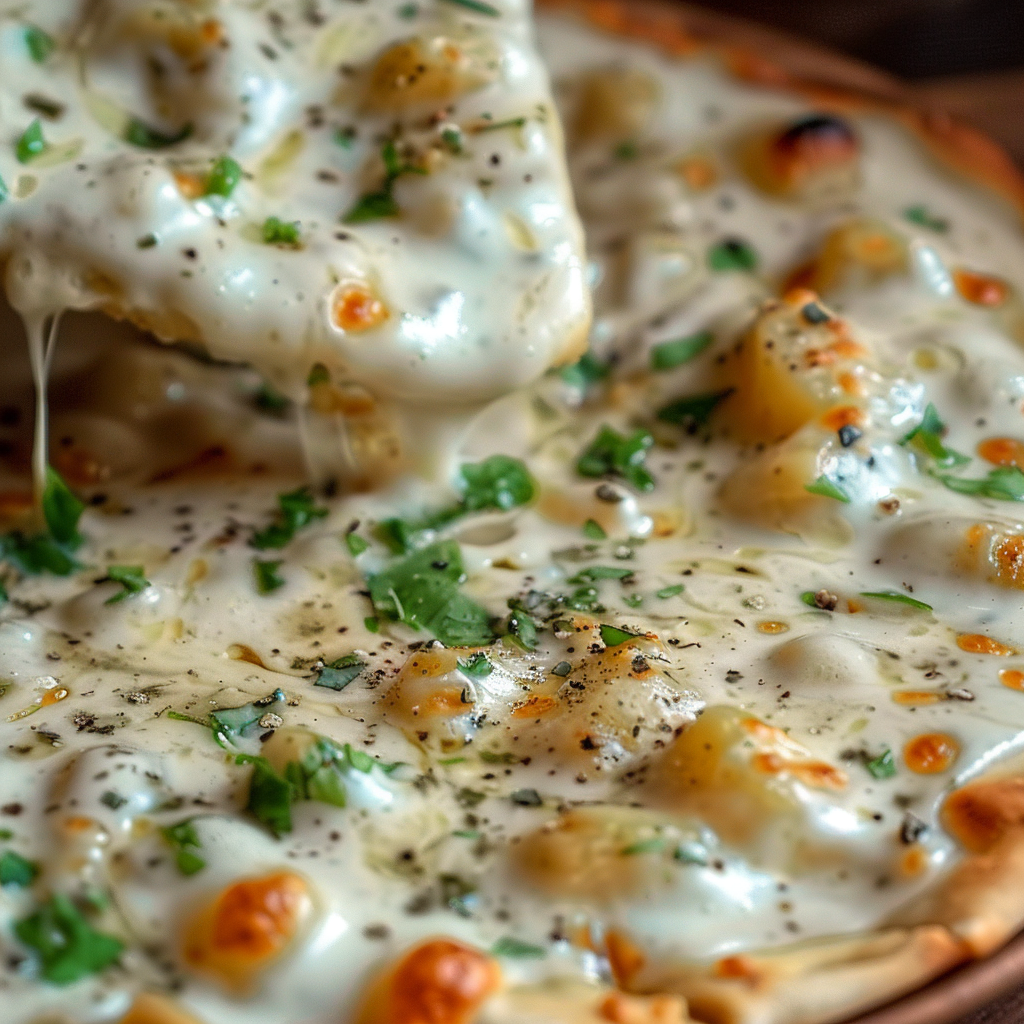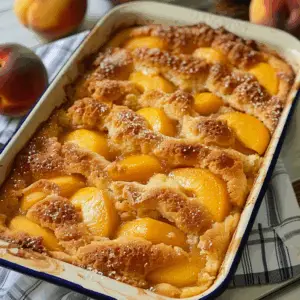White Pizza Sauce
If you’re looking to elevate your pizza night with something different from the traditional red sauce, learning how to make a creamy white pizza sauce is the perfect starting point. This garlic-forward, cheese-rich sauce transforms your ordinary pie into a gourmet experience, whether you’re cooking for family or entertaining guests. The appeal of this sauce lies in its balance of richness, creaminess, and bold flavor, making it an ideal base for a variety of toppings from spinach and mushrooms to grilled chicken and artichokes.
Unlike tomato-based sauces, white pizza sauce skips the acidity and leans heavily into dairy and aromatics, creating a smoother, richer bite. The key to achieving creamy garlic perfection is building your sauce slowly—from sautéing fresh garlic in butter to melting in freshly grated Parmesan cheese. You’ll find that the best results come from ingredients you likely already have at home, and with a little care, this sauce can become your go-to for not only pizza but other dishes like pasta or cheesy bread.
For example, once you master making a classic white sauce using a roux (Roux – Wikipedia), you can customize it easily. Want a little spice? Add red pepper flakes. Need more tang? Stir in a touch of goat cheese or lemon zest. And if you’re wondering what makes this different from Alfredo sauce, check out this breakdown of Pizza types to understand how it fits within pizza styles.
Planning your own homemade pizza night? Incorporating a flavorful base like this sauce not only enhances your pizza but also gives you the flexibility to experiment with toppings. Use it with flatbreads, drizzle it over cheesy garlic bread (Cheesy garlic bread ideas – Pinterest), or even mix it into pasta for a quick creamy dish. It’s an adaptable, tasty addition to any kitchen arsenal and an essential recipe for those who love bold flavors and homemade comfort food.

Why Make White Pizza Sauce at Home?
Making white pizza sauce at home offers a level of control and freshness you simply can’t get from store-bought alternatives. One of the biggest advantages is the ability to customize ingredients to suit your taste preferences or dietary needs. Whether you’re aiming for an extra creamy texture or dialing up the garlic flavor, crafting it from scratch ensures your sauce is exactly how you want it—without preservatives or unwanted additives.
Another compelling reason to make your own sauce is cost-effectiveness. A small jar of pre-made white sauce can be surprisingly expensive, especially if it includes quality ingredients like Parmesan cheese. But by purchasing basic staples like butter, whole milk, and flour in bulk, you can prepare multiple batches of sauce at a fraction of the cost. Not only is this budget-friendly, but it also allows you to whip up a fresh sauce whenever needed.
Homemade also means versatility. While it’s designed for pizza, this sauce doubles beautifully as a pasta base. Just imagine stirring it into your favorite noodles for a quick and indulgent garlic cream pasta. You can even serve it as a dip for vegetables, crackers, or breadsticks. For inspiration on how to extend its use, check out some creamy pasta sauces on Pinterest or get ideas from pizza sauce variations to tailor the flavor.
The homemade approach also lets you avoid common allergens or unwanted ingredients. Want a gluten-free version? Substitute the flour with gluten-free alternatives like cornstarch or arrowroot. Making it vegan? Use plant-based milk, vegan butter, and dairy-free cheese substitutes. This kind of flexibility is difficult to find in store-bought options.
In short, preparing your own white garlic pizza sauce is not only easier than it looks, but it’s also more flavorful, flexible, and affordable. Whether you’re prepping for a casual night in or planning a gourmet pizza spread, having a homemade sauce like this on hand is a game-changer.
Essential Ingredients and Why They Work
Every great white pizza sauce starts with a few core ingredients, each chosen for a specific function—flavor, texture, and richness. Understanding the role of each element allows you to customize the sauce while maintaining that signature creamy garlic perfection.
-
Butter: This is the base of your roux, giving the sauce its rich, smooth mouthfeel. Butter also enhances the depth of flavor and helps distribute the garlic evenly throughout the sauce.
-
Garlic: Fresh, minced garlic is the hero of this sauce. Sautéing it in butter brings out its natural sweetness and mellow depth. Unlike garlic powder, fresh garlic creates a bold, aromatic flavor that defines the sauce.
-
All-purpose flour: This combines with the butter to create a roux, the foundational step in building a sauce with structure. A roux thickens the mixture without clumping and ensures a silky texture.
-
Whole milk + heavy cream: These two work together to provide balance—milk offers a light, pourable base, while heavy cream adds luxurious body and fat content for that ultra-creamy result. Learn more about the science of cream and why it’s crucial in sauces.
-
Parmesan cheese: Adds sharpness and umami. The cheese thickens the sauce slightly and contributes a salty complexity. Use freshly grated Parmesan cheese for best results—pre-shredded options may contain anti-caking agents that affect texture.
-
Salt and ground black pepper: These basic seasonings enhance the flavor of the sauce without overpowering the garlic and cheese.
-
Oregano (optional): A touch of dried oregano adds a classic pizza flavor and pairs well with garlic and cheese. You can also explore other herbs like thyme or basil.
-
Crushed red pepper flakes (optional): For those who like a hint of heat, a small amount of chili flakes introduces a subtle spicy undertone.
If you’re making this sauce as part of a full homemade pizza night, these ingredients allow for pairing with countless toppings. Pinterest offers great topping ideas for white pizza, ranging from sautéed mushrooms and spinach to artichokes and prosciutto.
Not only are these ingredients easy to find, but they also combine to make a sauce that’s versatile enough for more than just pizza. Try it over roasted vegetables, inside stuffed mushrooms, or as a creamy addition to your next pasta dish. Looking for a way to turn this into a crowd-pleasing appetizer? Pair it with cheesy garlic bread for an irresistible side.
The magic of white pizza sauce lies in its simplicity—rich, balanced, and endlessly adaptable.
Step-by-Step Instructions (With Technique Tips)
Making white pizza sauce from scratch may sound complex, but it’s actually a straightforward process. The key is controlling heat, whisking at the right times, and using quality ingredients. Follow these steps for creamy garlic perfection every time.
Step 1: Sauté Garlic in Butter
-
In a medium saucepan, melt 2 tablespoons of butter over medium heat.
-
Add 4 minced garlic cloves and cook for about 30 seconds, just until fragrant—don’t let it brown.
-
Sautéing the garlic this way mellows the sharpness and infuses the butter with a deep, savory aroma.
-
Need more garlic flavor? Add a pinch of garlic powder for depth, but don’t substitute fresh garlic—it’s essential for authenticity.
Step 2: Create the Roux
-
Whisk in 2 tablespoons of all-purpose flour, stirring constantly.
-
Cook for 1 to 2 minutes to eliminate the raw flour taste.
-
This step forms a roux, the thickening base found in countless sauces, from béchamel to white pasta sauces.
-
Keep whisking—if you stop, the flour might clump or burn.
Step 3: Add Milk and Cream
-
Slowly pour in 1¼ cups of whole milk and ½ cup of heavy cream, whisking constantly.
-
Adding the liquid slowly ensures a smooth blend and prevents lumps.
-
Keep the heat at medium to avoid curdling—dairy needs gentle cooking.
-
This is the point where the sauce begins to come alive with its signature silky texture.
Step 4: Simmer Until Thickened
-
Let the mixture come to a gentle simmer, stirring frequently.
-
In about 5 minutes, it should thicken enough to coat the back of a spoon.
-
Don’t boil aggressively—too much heat can cause the dairy to separate.
Step 5: Stir in Cheese and Seasonings
-
Add ½ cup of freshly grated Parmesan cheese, ½ teaspoon salt, ¼ teaspoon black pepper, and optional ¼ teaspoon oregano and red pepper flakes.
-
Stir until the cheese melts completely and the sauce becomes velvety smooth.
-
Parmesan adds the salty, nutty bite that makes this sauce unforgettable. For added flavor layering, explore other cheeses like mozzarella or asiago.
Interested in making the sauce part of a themed meal? Check out homemade pizza night ideas for topping combinations and crust variations. You can also learn more about different pizza styles to understand where this sauce fits in.
Step 6: Cool Slightly Before Using
-
Remove from heat and let the sauce sit for a couple of minutes.
-
This helps it thicken a bit more and spread evenly on your pizza dough.
-
If the sauce becomes too thick, thin it with a splash of milk. If it’s too thin, return it to heat and simmer gently while stirring.
This recipe yields enough for 1 to 2 pizzas, depending on how saucy you like it. Don’t forget—this sauce isn’t just for pizza. Use leftovers for dipping, pasta, or over roasted veggies. And for pairing inspiration, dive into white pizza topping ideas that bring out the best in this sauce.
Storage and Reheating Tips
Storing your homemade white pizza sauce properly ensures that it maintains its creamy consistency and bold flavor for days. While the sauce is best fresh, it stores and reheats well with just a few simple techniques.
-
Refrigeration:
After the sauce cools to room temperature, transfer it to an airtight container. It can be stored in the refrigerator for up to 5 days. When refrigerated, the sauce will thicken—this is completely normal. -
Reheating:
Gently reheat the sauce on the stovetop over low heat, stirring frequently. To return it to the right texture, add a tablespoon or two of milk or cream while stirring. Avoid high heat, which can cause the dairy to separate. If you’re in a hurry, microwave it in short intervals (20–30 seconds), stirring in between. -
Freezing:
Yes, this sauce can be frozen, although the texture may change slightly. Use a freezer-safe container and store it for up to 2 months. When ready to use, thaw overnight in the fridge and reheat slowly with a splash of milk to revive the creaminess. -
Batch Prep Tip:
Consider making a double batch and storing individual portions. You’ll have white garlic pizza sauce ready to go for pasta, garlic bread, or a quick pizza night. For pairing inspiration, explore cheesy garlic bread ideas to use with your leftovers.
Having sauce ready to go saves time and ensures your next meal starts with a flavorful foundation. Whether refrigerated or frozen, this sauce proves just as convenient as it is delicious.

Delicious Ways to Use White Pizza Sauce
Once you’ve made this creamy garlic white sauce, you’ll find countless ways to use it beyond pizza. Its mild richness and garlicky base pair beautifully with many ingredients and dishes.
-
White pizza:
Spread it on your dough and top with fresh mozzarella, grilled chicken, sautéed spinach, mushrooms, or roasted garlic. For topping ideas, explore white pizza topping inspiration for unique combinations. -
Pasta:
Toss with cooked pasta for a quick and indulgent garlic cream sauce. Add roasted veggies or grilled shrimp for a full meal. See examples on Pinterest. -
Cheesy garlic bread:
Use it as a spread on toasted baguettes or pizza dough. Top with mozzarella and broil until bubbly. -
Dipping sauce:
Serve alongside breadsticks, garlic knots, or even raw vegetables. -
Stuffed mushrooms or casseroles:
Stir into a vegetable bake or use in stuffed mushroom caps for a creamy twist. -
Panini or sandwich spread:
Spread a thin layer on crusty bread before toasting for an extra layer of flavor.
This versatile sauce enhances almost anything it touches, whether as a main component or a finishing drizzle.
Flavor Variations and Add-Ins
The base white pizza sauce recipe is delicious as-is, but it also offers endless customization options. Try these simple twists to match your tastes or specific dish:
-
Herbs:
Add fresh or dried basil, thyme, or rosemary for aromatic depth. Oregano is a classic choice, especially for pizza. -
Cheese blends:
Mix in mozzarella, provolone, or asiago for more melt and stretch. Parmesan gives sharpness, but other cheeses add creaminess and variety. -
Zest and acid:
Add a touch of lemon zest or a squeeze of lemon juice to brighten the richness of the sauce. -
Vegetable purées:
Stir in blended roasted red peppers, spinach, or butternut squash for color and flavor. -
Heat:
Increase the crushed red pepper flakes, or add cayenne or hot sauce for a spicy version. -
Meat infusions:
Sauté finely chopped bacon, pancetta, or chicken before starting your roux for a meaty flavor base. -
Vegan or dairy-free:
Use olive oil instead of butter, and swap in unsweetened almond milk or oat milk, plus a vegan cheese substitute.
Customizing allows you to match the sauce to the meal—whether it’s a pizza with spinach and artichoke, or a lemony seafood pasta.
Troubleshooting Common Mistakes
While this sauce is easy to make, a few common issues can trip up even experienced cooks. Here’s how to fix them:
-
Too thin:
Simmer longer, or add a mix of flour and melted butter to thicken. Cheese can also help tighten the sauce. -
Too thick:
Add a splash of warm milk or cream and whisk to loosen. -
Lumpy texture:
Whisk vigorously when adding milk to the roux. If lumps remain, strain the sauce through a mesh sieve. -
Bland flavor:
Adjust salt, add more garlic, or increase the cheese. Remember, fresh Parmesan brings a lot of flavor. -
Curdled or separated:
This happens when dairy is overheated. Always cook on medium to low heat and add liquids slowly.
Understanding these quick fixes will help you save your sauce and improve it every time you make it.
Nutrition Info and Dietary Notes
While this creamy white garlic sauce is indulgent, it’s easy to adjust to meet your dietary goals.
-
Calories:
Approximately 100–120 calories per 2-tablespoon serving, depending on exact ingredients. -
Carbs & fat:
Rich in fat due to cream and butter; moderate in carbs because of the flour base. -
Vegetarian:
This recipe is naturally vegetarian if using real cheese and dairy. -
Gluten-free option:
Use gluten-free flour or cornstarch instead of all-purpose flour. -
Keto-friendly:
Skip the flour and use xanthan gum for thickening. Stick to high-fat cream and cheese. -
Dairy-free/vegan:
Swap butter and dairy with vegan options. Nutritional yeast can mimic the cheesy flavor of Parmesan.
Always read ingredient labels if you’re preparing for someone with allergies or dietary restrictions. Customize this base to suit your lifestyle without compromising flavor.

FAQs
What is white pizza sauce made of?
White pizza sauce is made from butter, garlic, flour, milk, cream, and Parmesan cheese, often seasoned with salt, pepper, and optional herbs or chili flakes.
Is white pizza sauce the same as Alfredo sauce?
Not exactly. Both are creamy, but white pizza sauce is typically thicker, uses less cheese, and is designed to stay put on pizza crust. More on Alfredo sauce here.
Can I make white pizza sauce without cream?
Yes, you can use all whole milk or substitute with half-and-half. Just be aware it may be slightly less rich.
Can I use this sauce on pasta?
Absolutely. It makes an excellent base for pasta dishes, especially when paired with roasted vegetables or grilled chicken.
What cheese goes well with white pizza sauce?
Mozzarella, provolone, ricotta, and asiago all pair well with the sauce. Use Parmesan for depth and saltiness.
Can I freeze white pizza sauce?
Yes. Freeze in an airtight container for up to 2 months. Thaw in the fridge and reheat gently on the stove with a splash of milk.
Why is my white sauce not thickening?
The roux might need more time to cook, or you may not have added enough flour. Simmer longer and whisk frequently.
Is white pizza sauce healthier than tomato sauce?
Not usually—white sauces are higher in fat and calories due to dairy. However, they are richer and more filling, so you may use less overall.
How to Make White Pizza Sauce Creamy Garlic Perfection
This creamy white pizza sauce is a rich, garlicky, homemade alternative to traditional tomato-based pizza sauces. Made with real butter, fresh garlic, whole milk, heavy cream, and Parmesan cheese, it’s ultra-smooth and full of flavor. Perfect for white pizzas, pasta, breadsticks, and more, this versatile sauce is ready in just 15 minutes and can be easily customized to suit your taste or dietary preferences.
- Author: Clara
Ingredients
- 2 tablespoons butter
- 4 garlic cloves, minced
- 2 tablespoons all-purpose flour
- 1 ¼ cups whole milk
- ½ cup heavy cream
- ½ cup grated Parmesan cheese
- ½ teaspoon salt
- ¼ teaspoon ground black pepper
- ¼ teaspoon dried oregano (optional)
- ¼ teaspoon crushed red pepper flakes (optional)
Instructions
Melt the butter in a medium saucepan over medium heat. Add the minced garlic and sauté until fragrant, about 30 seconds.
Whisk in the flour and cook for 1-2 minutes to eliminate the raw flour taste.
Slowly whisk in the milk and heavy cream, stirring constantly to prevent lumps.
Bring the mixture to a gentle simmer, stirring frequently until it begins to thicken.
Stir in the grated Parmesan cheese, salt, pepper, oregano, and red pepper flakes (if using). Continue to stir until the cheese has melted and the sauce is smooth and creamy.
Remove from heat and let the sauce cool slightly before spreading on your pizza dough.
Notes
-
Always use fresh garlic for the best flavor—avoid pre-minced or jarred versions.
-
Use freshly grated Parmesan for a smoother melt and better taste.
-
Adjust consistency with milk (to thin) or a flour/butter slurry (to thicken).
-
The sauce thickens as it cools; reheat gently to restore its creamy texture.
-
Great make-ahead option—store in the fridge or freeze in portions.
-
Customize with herbs, cheeses, or heat depending on your recipe.
-
This sauce is excellent for pizza, pasta, garlic bread, sandwiches, and casseroles.




